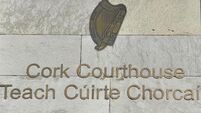National Museum to bring ancient psalter to life
Experts at the National Museum are planning to bring to life one of the country’s most significant and mysterious historical finds, the ancient book of psalms found in a Tipperary bog two years ago.
Known as the 'Faddan Mor Psalter', the 1,200-year-old decorated manuscript was a working text in everyday use by monks for praying, teaching or for copying religious passages.
It is being painstakingly analysed and preserved in attempt to learn more about its origins even though only around 15% of the vellum pages survived the bog burial.
Now it is hoped the entire book can be recreated using digital technology or re-written in Latin by a calligraphy expert following the monastic style of the eighth century.
Raghnall O’Floinn, head of collections at the museum, said the aim is to have something people can see, read or even touch.
“For display, we would hope to create a digital version and perhaps a facsimile copy,” he said.
“We need someone to make a physical copy, someone who will by hand try and put it together using the same kind of inks and colours and pigmentation. Because it is so fragmented that’s a problem to create a true copy. What we could do is create our best guess.”
The psalter was unearthed by a turf cutter from the Faddan Mor bog in Tipperary in July 2006 but its origins remain a mystery.
One theory suggests it was hurriedly dumped in the bog in mid-eighth century along with a crumpled, leather carrying bag and an animal pelt to hide the book, both of which were fairly well preserved.
The manuscript sat upright in the bog for over 1,000 years suggesting it may have been thrust into the soaking wet ground as the holder fled.
Analysis by John Gillis, senior book and manuscript conservator at the museum, revealed other secrets – whoever left it behind did not close the outer leather cover or button it around the manuscript.
A flap which would have helped seal the manuscript was tucked in the wrong end of the psalter and a loose button has left an indentation on the back pages.
“There seems to be a possibility that it was deposited in the bog, that someone hid it,” Mr Gillis said.
“The bog was there when the book was deposited, the bog didn’t come after.”
The psalter’s origins are not yet known. The ancient Birr Monastery was nearby but forensic analysis has failed to find any notes, markings or names on the text that may offer clues about who wrote it.
“If you got a name or a place you would be able to locate it. Unfortunately there is nothing like that, although we know the text. It’s like a giant jigsaw puzzle,” Mr Gillis said.
“I wouldn’t be confident of finding a note, but I would be hopeful. To date there is very little if anything – no notes in the margins, nobody has scribbled on this thing, nobody has noted anything.”
The texts are written in Latin with many pages colourfully decorated with yellow, red, white and green however these have faded badly over the years. However it is not as ornately made as the Book of Kells and was more likely a working text, used everyday.
It contains a version of the Gallican Psalter, made by St Jerome in 392 AD, which later became popular in Gaul, modern day France, and by far the most popular version in Ireland for centuries.
Museum staff said the text is very similar to the Cathach, the earliest surviving Irish manuscript and also a psalter.
Experts have likened the find to the discovery of biblical texts from the dry sands of Egypt.
Details of the find, analysis and the preservation work carried out over the last 18 months will be presented at a public lecture in museum’s Kildare Street wing on Thursday.












